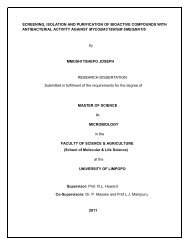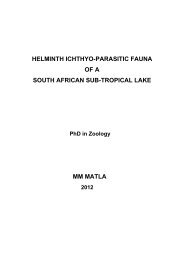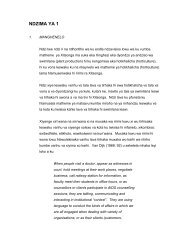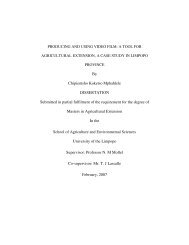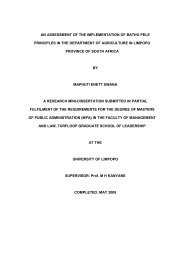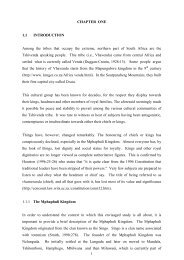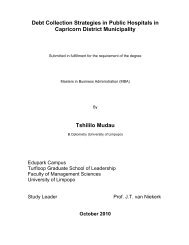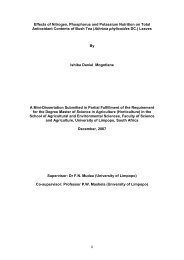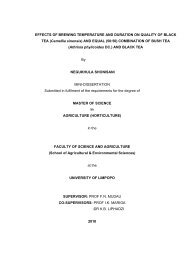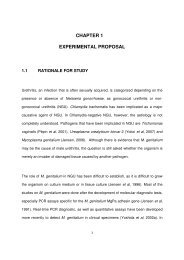Thesis submitted 23-03-2012.pdf - University of Limpopo ...
Thesis submitted 23-03-2012.pdf - University of Limpopo ...
Thesis submitted 23-03-2012.pdf - University of Limpopo ...
You also want an ePaper? Increase the reach of your titles
YUMPU automatically turns print PDFs into web optimized ePapers that Google loves.
pure single compounds that exhibit photosensitization properties and they<br />
include a number <strong>of</strong> porphyrins and phthalocyanines derivatives.<br />
1.9.6.2 Porphyrins<br />
Porphyrins are a group <strong>of</strong> organic compounds many <strong>of</strong> which occur in<br />
nature. One <strong>of</strong> the best known is heme, the pigment in red blood cells.<br />
Heme is a c<strong>of</strong>actor <strong>of</strong> the protein hemoglobin.They are aromatic<br />
heterocyclic macrocycles composed <strong>of</strong> four modified pyrrole subunits<br />
interconnected at their α carbon atoms via methine bridges (═CH─).<br />
Porphyrins are aromatic. That is, they obey Hückel's rule for aromaticity,<br />
possessing 4n+2 π-electrons (n=4 for the shortest cyclic path around the<br />
macrocycle) that are delocalized over the macrocycle. The macrocycles,<br />
therefore, are highly-conjugated systems. Consequently, they typically<br />
have very intense absorption bands in the visible region and may be deeply<br />
colored. The name porphyrin comes from a Greek word for purple. The<br />
macrocycle has 26 pi electrons in total. The parent porphyrin is porphine,<br />
and substituted porphines are called porphyrins.<br />
One <strong>of</strong> the more common synthetic routes for porphyrins is based on work<br />
by Paul Rothemund. 37a His techniques underpin more modern syntheses<br />
such as those described by Adler and Longo. 37b The synthesis <strong>of</strong> simple<br />
porphyrins such as meso-tetraphenylporphyrin (H2TPP) is also commonly<br />
carried out in university teaching labs. 37c It can be done by heating an<br />
equimolar mixture <strong>of</strong> pyrrole and benzaldehyde in refluxing propionic acid<br />
for about an hour.<br />
Using this method, porphyrins are assembled from pyrrole and substituted<br />
aldehydes. Acidic conditions are essential for porphyrin formation; formic<br />
acid, acetic acid, and propionic acid are typical reaction solvents, or p-<br />
toluenesulfonic acid can be used with a non-acidic solvent. Lewis acids<br />
such as boron trifluoride etherate and ytterbium triflate have also been<br />
26



